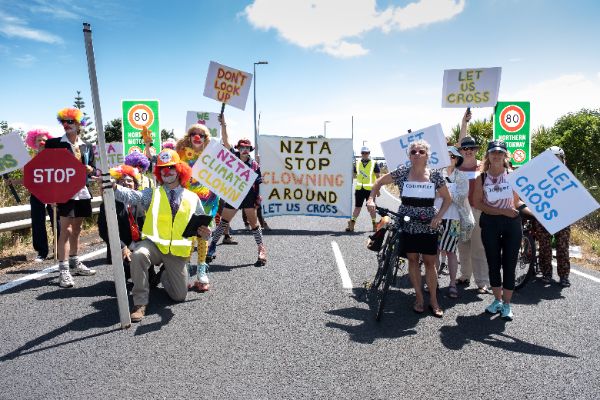Colourful Auckland Harbour Bridge Protest

A creative group of walking and cycling advocates will stage a colourful intervention on the Curran St onramp of the Auckland Harbour Bridge at 11am on 5 January. They are calling for NZTA / Waka Kotahi to allow walking and cycling on an existing bridge lane on a permanent basis.
The northbound bridge clip-ons are closed for maintenance, and the Curran St onramp is also closed to traffic.
The advocates say the Transport Agency is clowning around with the climate by failing to provide walking and cycling across the critically important structure. The Auckland Harbour Bridge currently carries eight lanes of vehicle traffic and is one of the few major bridges in the world to preclude walking and cycling.
‘NZTA are clowning around with the climate and clowning around with walking and cycling. This creative and colourful protest will reflect that’, says spokesperson Christine Rose.
‘Walking and cycling are climate action. But NZTA treats them like a joke’, says Rose. ‘Transport contributes 21% of New Zealand’s greenhouse gas emissions but NZTA is clowning around on the climate by failing to provide walking and cycling across Auckland’s iconic harbour bridge’.
‘The Harbour Bridge northbound clip-ons have been closed since Boxing Day, for maintenance throughout the summer break, but they are mostly sitting empty, when they could have opened to walkers and cyclists for a few days at least’. ‘This could and should be a precursor to permanent access for people on foot and bike’.
NZTA representatives recently presented to Parliament’s Transport and Infrastructure Select Committee ruling out a dedicated lane for walking and cycling, though the Agency is to report back in March with options for opening lanes in future summers. ‘NZTA’s internal advice is that a permanently dedicated lane is feasible’, says Rose.
Rose says, ‘Getting people across the harbour by foot and bike has been key Labour Party policy. NZTA needs to stop clowning around, and provide a permanent lane on the existing structure for walking and cycling’. ‘Current suggestions that walkers and cyclists could take a ferry or bus instead, are a farce’.


 Gordon Campbell: On Peter Dutton’s Fading Election Prospects.
Gordon Campbell: On Peter Dutton’s Fading Election Prospects. Sensible Sentencing Trust: Greens Claim Intellectual Property Rights And Demand Changes To “Defund The Police” Billboards
Sensible Sentencing Trust: Greens Claim Intellectual Property Rights And Demand Changes To “Defund The Police” Billboards Te Pūtahitanga o Te Waipounamu: New Research Finds Dumped South Island Whānau Ora Agency An Exemplar Of Effective, Community-Led Public Service Delivery
Te Pūtahitanga o Te Waipounamu: New Research Finds Dumped South Island Whānau Ora Agency An Exemplar Of Effective, Community-Led Public Service Delivery NZ Nurses Organisation: Nurses’ Union Backs Call To Scrap Anti-Treaty Bill
NZ Nurses Organisation: Nurses’ Union Backs Call To Scrap Anti-Treaty Bill New Zealand Defence Force: Final Court Of Inquiry Into HMNZS Manawanui Grounding And Sinking In Samoa Released
New Zealand Defence Force: Final Court Of Inquiry Into HMNZS Manawanui Grounding And Sinking In Samoa Released Organics Aotearoa NZ: Gene Tech Bill - A High-Stakes Gamble That Risks Farmers’ Livelihoods, Trade, And NZ’s Global Reputation
Organics Aotearoa NZ: Gene Tech Bill - A High-Stakes Gamble That Risks Farmers’ Livelihoods, Trade, And NZ’s Global Reputation Fire and Emergency NZ: Check Your Smoke Alarms When Clocks Go Back This Sunday
Fire and Emergency NZ: Check Your Smoke Alarms When Clocks Go Back This Sunday


